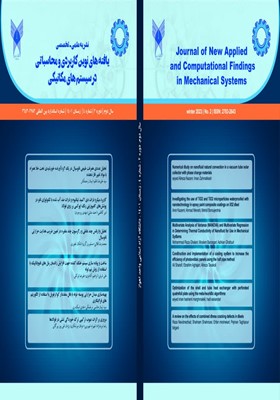کاربرد میکرو ذرات دی اکسید تیتانیوم و ذرات ضد آب شده با تکنولوژی نانو در پوششهای کامپوزیتی رنگ اپوکسی بر روی فولاد X52
محورهای موضوعی : یافته های نوین کاربردی و محاسباتی در سیستم های مکانیکیامیر کاظمی 1 , احمد منشی 2 * , مهدی بروجردنیا 3
1 - گروه مهندسی مواد، واحد اهواز، دانشگاه آزاد اسلامی، اهواز، ایران.
2 - گروه مهندسی مواد، دانشگاه صنعتی اصفهان، اصفهان، ایران.
3 - گروه مهندسی مواد و متالورژی، دانشگاه آزاد اسلامی، واحد اهواز، اهواز، ایران
کلید واژه: پوشش کامپوزیت, مقاومت به سایش, دی اکسید تیتانیوم ضد آب, مقاومت به خوردگی, رنگ اپوکسی,
چکیده مقاله :
در این پژوهش دو نوع پوشش کامپوزیتی بر پایه رنگ اپوکسی تقویت شده توسط نانو و میکرو ذرات دی اکسید تیتانیوم و ذرات آبگریز شده آن به طور جداگانه و با غلظتهای 1، 2، 3، 4 و 5 درصد وزنی برای بهبود ویژگیهای رنگ اپوکسی تهیه شد. به منظور بررسی رفتار آن ها بر روی فولاد X52 اعمال گردیدند و سپس با انجام آزمونهای خوردگی و سایش خواص آن ها مورد بررسی قرار گرفت. ضخامت پوششها توسط دستگاه ضخامت سنج دیجیتال بررسی شدو رفتار مقاومت به خوردگی پوششها با استفاده از روش پلاریزاسیون در محلول سدیم کلرید 5/3% ارزیابی شد. نتایج آزمون خوردگی نشان داد که با اضافه کردن و افزایش غلظت ذرات تقویت کننده در پوششها مقاومت به خوردگی بهبود یافته و همچنین پوشش کامپوزیتی رنگ اپوکسی دارای 5 درصد وزنی تقویت کننده دی اکسید تیتانیوم آبگریز شده، مقاومت به خوردگی بهتری نسبت به سایر نمونهها از خود نشان می دهد. برای بررسی خواص مورفولوژی سطح از میکروسکوپ الکترونی روبشی مجهز استفاده گردید. نتایج به دست آمده از این آنالیز توزیع مناسب و یکنواخت ذرات آبگریز شده در زمینه پوشش اپوکسی را نشان داده است. مقاومت به سایش پوششها توسط دستگاه آزمون گلوله بر روی دیسک انجام شد. نتایج آزمون سایش نشان داد که با اضافه کردن و افزایش غلظت ذرات تقویت کننده در پوشش مقاومت سایشی پوشش افزایش یافته، اما با مقایسه نمونههای کامپوزیتی اپوکسی مشخص گردید که آبگریز شدن ذرات تقویت کننده تاثیری بر مقاومت به سایش نداشته است.
In this research, two types of composite coatings based on epoxy paint reinforced by TiO2 nano and micro particles and TiO2 particles hydrophobicized by polysiloxane were prepared separately with concentrations of 1, 2, 3, 4 and 5% by weight to improve the properties of epoxy paint. and in order to investigate their behavior, they were applied on API 5L X52 steel and then their properties were investigated by conducting corrosion and wear tests. The thickness of the coatings was checked by a digital thickness gauge. The corrosion resistance behavior of the coatings was evaluated using the polarization method in 3.5% NaCl solution. The results of the corrosion test showed that by adding and increasing the concentration of reinforcing particles in the coatings, the corrosion resistance was improved, and also the composite coating of epoxy paint with 5% by weight of the hydrophobic TiO2 reinforcement showed better corrosion resistance than other samples. A scanning electron microscope (SEM) equipped with EDX was used to examine the morphological properties of the surface. In order to check the dispersion of micro particles in the field of coating, Map analysis was taken from the samples. The results obtained from Map analysis have shown the appropriate and uniform distribution of hydrophobic particles in the field of epoxy coating. The wear resistance of the coatings was performed by the bullet test machine on the disc. The results of the abrasion test showed that by adding and increasing the concentration of reinforcing particles in the coating, the abrasion resistance of the coating increased, but by comparing the epoxy composite samples, it was found that the hydrophobicity of the reinforcing particles had no effect on the abrasion resistance.
_||_
[1] Xing, X. S., Li, R. K. Y., (2004), Wear Behavior of Epoxy–Matrix Composites Filled with Uniform Sized Sub-Micron Spherical Silica Particles, Wear, 256, pp 21-26.
[2] Ramesh, K., Nayak, A. D., Ray, B. C., (2014), Effect of epoxy modifiers (Al2O3/SiO2/TiO2) on mechanical performance of epoxy/glass fiber hybrid composites, Procedia Materials Science, 6, pp 1359-1364.
[3] Kali, D. (2013), Study on Mechanical and Dry Sliding Wear Characteristics of Meta-Cresol Novalac Epoxy Composites Filled with Silicon Carbide, Aluminum Oxide, and Zinc Oxide Particulates, Tribology Transactions, 57 (2), pp 157-172
[4] Hongwei, Sh., (2007), Characterization of protective performance of epoxy. Reinforced with nanometer-sized TiO2 and SiO2, Progress in Organic Coatings, 62, pp 359-368.
[5] Behzadnasab,M., (2011), Corrosion performance of epoxy coatings containing silane treated ZrO2 nanoparticles on mild steel in 3.5% NaCl solution, Corrosion Science, 53, pp 89-98.
[6] Mahrholz. T., (2009), Quantitation of the reinforcement effect of silica nanoparticles in epoxy resins used in liquid composite moulding processes, Composites, 40, pp 235-243.

